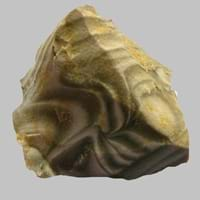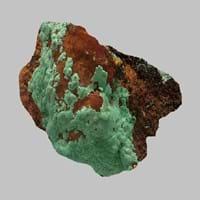Definition
Flint is a hard type of sedimentary rock that produces a small piece of burning material when hit by steel
Gossan is intensely oxidized, weathered or decomposed rock, usually the upper and exposed part of an ore deposit or mineral vein.
Discoverer
Unknown
Cornish Gossen
Etymology
From Old English flint - a type of rock mainly known for high hardness and for giving off sparks when struck
From Cornish gossen from gos, blood from Old Cornish guit
Class
Sedimentary Rocks
Metamorphic Rocks
Sub-Class
Durable Rock, Hard Rock
Durable Rock, Medium Hardness Rock
Group
Not Applicable
Not Applicable
Other Categories
Fine Grained Rock, Opaque Rock
Fine Grained Rock, Medium Grained Rock, Opaque Rock
Texture
Banded, Rough
Rough, Sandy
Color
Black, Brown, Green, Grey, Red, White
Brown, Brown- Black, Gold, Green, Rust
Durability
Durable
Durable
Scratch Resistant
Yes
Yes
Appearance
Glassy or Pearly
Dull and Banded
Interior Uses
Decorative Aggregates, Homes, Interior Decoration
Countertops, Decorative Aggregates, Interior Decoration
Exterior Uses
As Building Stone, As Facing Stone, Garden Decoration, Office Buildings, Paving Stone
As Building Stone, As Facing Stone, Paving Stone, Garden Decoration, Office Buildings
Other Architectural Uses
Curbing
Curbing
Construction Industry
Arrowheads, Cutting Tool, Spear Points
As Dimension Stone, Cement Manufacture, Construction Aggregate, for Road Aggregate
Medical Industry
Not Yet Used
Not Yet Used
Antiquity Uses
Artifacts
Artifacts
Commercial Uses
Creating Artwork, Gemstone, In fire-starting tools, Manufacture of tools, Metallurgical Flux, Jewelry, To ignite fire, Used in flintlock firearms
Cemetery Markers, Commemorative Tablets, Gemstone
Types
Not Available
Translocated gossan and Leakage gossan
Features
Clasts are smooth to touch, Easily splits into thin plates, Has High structural resistance against erosion and climate
Clasts are smooth to touch, Easily splits into thin plates
Archaeological Significance
Monuments
Not Yet Used
Not Yet Used
Famous Monuments
Not Applicable
Not Applicable
Sculpture
Not Yet Used
Not Yet Used
Famous Sculptures
Not Applicable
Not Applicable
Pictographs
Not Used
Used
Petroglyphs
Not Used
Used
Figurines
Not Yet Used
Not Yet Used
Formation
Flint is formed by the decomposition and compaction of various organisms such as sponges and diatoms under the water.
Earth movements can cause rocks to be either deeply buried or squeezed and hence the rocks are heated and put under great pressure.
Mineral Content
Silicon
Apatite, Augite, Biotite, Bronzite, Calcite, Chert, Epidote, Feldspar, Hornblende, Micas, Plagioclase, Pyroxene, Quartz, Sulfides, Zircon
Compound Content
Silicon Dioxide
Aluminium Oxide, CaO, Fe, FeO, Silicon Dioxide, Sulphur
Types of Metamorphism
Not Applicable
Not Applicable
Types of Weathering
Not Applicable
Not Applicable
Types of Erosion
Chemical Erosion, Coastal Erosion, Water Erosion
Chemical Erosion, Sea Erosion, Wind Erosion
Grain Size
Very fine-grained
Fine to Medium Grained
Fracture
Conchoidal
Conchoidal
Streak
White
White to Grey
Porosity
Highly Porous
Highly Porous
Compressive Strength
Not Available
Cleavage
Non-Existent
Not Available
Toughness
1.5
Not Available
Specific Gravity
2.5-2.8
2.0
Transparency
Translucent to Opaque
Opaque
Density
2.7-2.71 g/cm3
Not Available
Resistance
Heat Resistant, Impact Resistant, Pressure Resistant, Wear Resistant
Heat Resistant, Impact Resistant, Pressure Resistant
Deposits in Eastern Continents
Asia
Azerbaijan, China, Russia
China, India, Indonesia, Russia, Singapore, South Korea
Africa
Not Yet Found
Cape Verde, Ethiopia, Ghana, South Africa, Western Africa
Europe
Austria, Belgium, Cyprus, Denmark, France, Germany, Italy, Malta, Netherlands, Poland, Portugal, Romania, Spain, Sweden, Switzerland, Turkey, Ukraine, United Kingdom
Albania, France, Germany, Great Britain, United Kingdom
Others
Not Yet Found
Not Yet Found
Deposits in Western Continents
North America
USA
Canada, USA
South America
Bolivia
Brazil, Colombia, Ecuador
Deposits in Oceania Continent
Australia
New Zealand, South Australia
New South Wales, South Australia, Western Australia
All about Flint and Gossan Properties
Know all about Flint and Gossan properties here. All properties of rocks are important as they define the type of rock and its application. Flint belongs to Sedimentary Rocks while Gossan belongs to Metamorphic Rocks.Texture of Flint is Banded, Rough whereas that of Gossan is Rough, Sandy. Flint appears Glassy or Pearly and Gossan appears Dull and Banded. The luster of Flint is vitreous while that of Gossan is metallic. Flint is available in black, brown, green, grey, red, white colors whereas Gossan is available in brown, brown- black, gold, green, rust colors. The commercial uses of Flint are creating artwork, gemstone, in fire-starting tools, manufacture of tools, metallurgical flux, jewelry, to ignite fire, used in flintlock firearms and that of Gossan are cemetery markers, commemorative tablets, gemstone.










